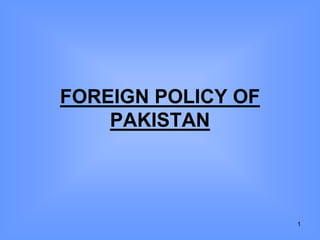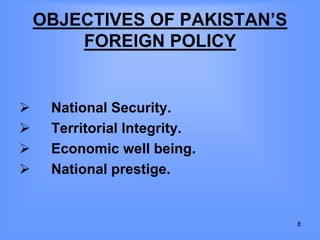foreign-policy-of-pakistan.ppt
- 2. N W E S 2
- 3. GEO-STRATEGIC IMPORTANCE OF PAKISTAN Location West part of South Asia. It lies between the latitudes of 23.30 degree and 35.45 degree north and between the longtitudes of 61 degree and 75.31 degree east of Greenwich. 3
- 4. GEO-STRATEGIC IMPORTANCE OF PAKISTAN Total Area 796096 sq km broad East to West. 1600 kms north to south and about 885 kms broad east to west. 4
- 5. GEO-STRATEGIC IMPORTANCE OF PAKISTAN Boundaries March with Iran, Afghanistan and India bounded to west by Iran. To the North by Afghanistan to the North East by China. To the East and South East by India and to the South by Arabian Sea Pakistan is separated from Tajikistan by a narrow strip of Afghan territory called ŌĆ£WAKHANŌĆØ 5
- 6. GEO-STRATEGIC IMPORTANCE OF PAKISTAN PAKISTAN shares border 2252 km long common border (Durand Line) with Afghanistan, 585 kms long border with China, 805 kms long border with Iran and 700 kms long coast with the Arabian Sea. 6
- 7. FOREIGN POLICY OF PAKISTAN Definition ŌĆ£The external policy of an independent, sovereign state which it pursues in its relations with other nations of the world in order to seek its national interest.ŌĆØ ŌĆ£The external policy of the state which it pursues to preserve its ideological character, safeguard its territorial integrity, maintain its political sovereignty and guarantee its economic well beingŌĆØ 7
- 8. OBJECTIVES OF PAKISTANŌĆÖS FOREIGN POLICY ’āś National Security. ’āś Territorial Integrity. ’āś Economic well being. ’āś National prestige. 8
- 9. DETERMINENTS OF PAKISTANŌĆÖS FOREIGN POLICY ’āś Geo-Political Settings. ’āś Historical Legacies and Past Traditions. ’āś Socio-Economic Condition. ’āś Political Systems and Structure. ’āś Ideological Considerations. ’āś Decision Makers Dream, Images and Motives. ’āś External Environment. ’āś Power Considerations. ’āś National Interest. 9
- 10. ELEMENTS AFFECTING FOREIGN POLICY ’üČ Technology leaves impact on foreign policy. ’üČ The national capacity of a state also exercises profound influence on the foreign policy of state. ’üČ The social structure of a society also exercise profound influence on its foreign policy. ’üČ Public opinion is another important element of countryŌĆÖs foreign policy. 10
- 11. ELEMENTS AFFECTING FOREIGN POLICY ’üČ The political organization found in a country also greatly influences the foreign policy. For example under authoritarian systems quick foreign policy decisions are taken. ’üČ The press also plays a vital role in foreign policy formulation process. ’üČ The nature of political accountability prevailing in a system also greatly influence the foreign policy of the state. ’üČ The leadership also plays a vital role in the shaping of a countryŌĆÖs foreign policy. ’üČ The great power structure prevailing in the world politics also greatly influence the policy of a country. 11
- 12. ELEMENTS AFFECTING FOREIGN POLICY ’üČ While making foreign policy the state has to take note of the international law, treaties and contracts. ’üČ While formulating its foreign policy a country has to take note of the reaction of other states to its various actions. ’üČ Alliances concluded by various states also greatly influence the foreign policy. ’üČ The world public opinion also influences the stateŌĆÖs foreign policy. 12
- 13. PHASES OF PAKISTANŌĆÖS FOREIGN POLICY Phase-I 1947-53 (The Era of Neutrality) Phase-II 1954-62 (The Era of Alignment) (1) Pak-US Mutual Defense Assistance Agreement. (2) South-East Asian Treaty Organization ( SEATO) (3) Central Treaty Organization (CENTO) 13
- 14. PHASES OF PAKISTANŌĆÖS FOREIGN POLICY Phase-III 1963-77 (The Era of Bilateralism) Phase-IV 1978-89 (The Era of Non Alignment) Phase-V 1999 Onwards (Quest for Multilateral Foreign Policy) Restructuring of Foreign Policy. 14













